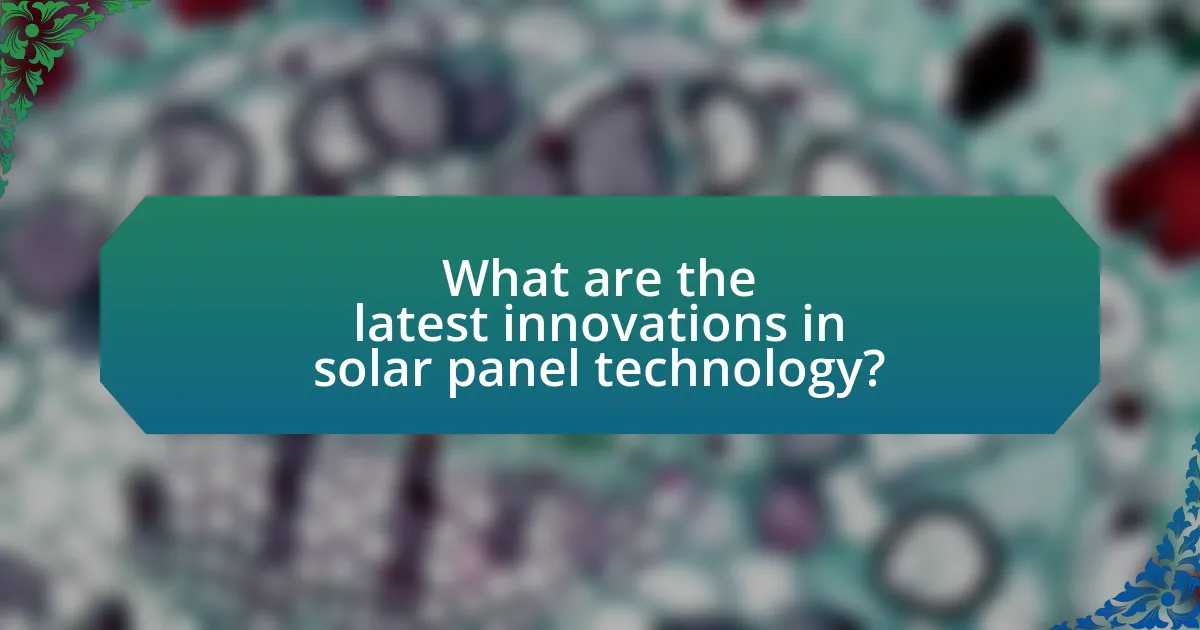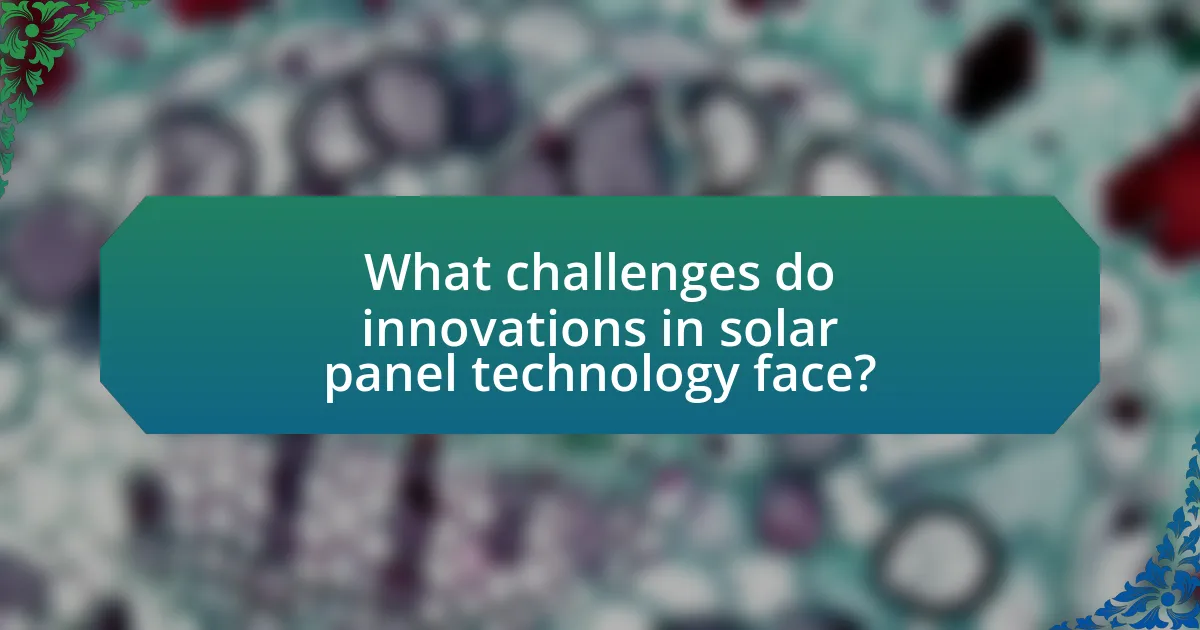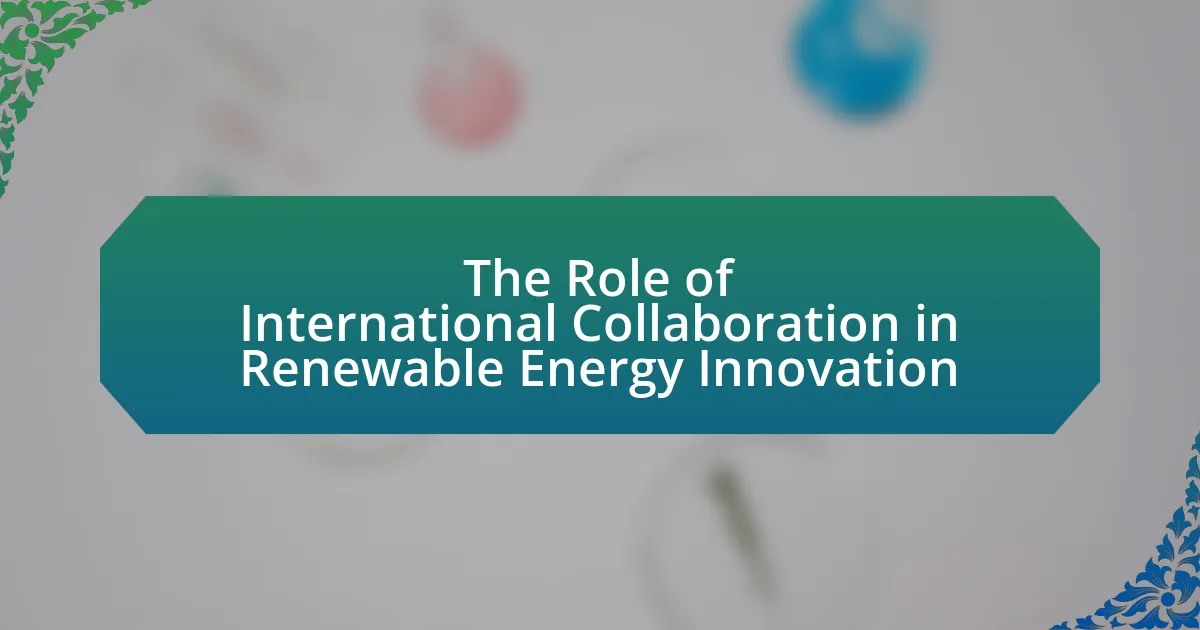The article focuses on the latest innovations in solar panel technology, highlighting advancements such as bifacial solar panels, which enhance energy output by capturing sunlight on both sides, and perovskite solar cells, known for their high efficiency and lower production costs. It discusses how recent developments have improved solar panel efficiency, the role of new materials in production, and the impact of technology on solar panel design. Additionally, the article examines the environmental benefits of solar energy innovations, the economic factors influencing adoption, and the challenges faced in scaling these technologies. Overall, it emphasizes the significance of ongoing research and development in shaping the future of photovoltaics and promoting sustainability.

What are the latest innovations in solar panel technology?
The latest innovations in solar panel technology include the development of bifacial solar panels, which capture sunlight on both sides, increasing energy output by up to 30%. Additionally, perovskite solar cells have emerged, offering higher efficiency rates and lower production costs compared to traditional silicon cells. Research indicates that perovskite cells can achieve efficiencies exceeding 25%, while also being lightweight and flexible, making them suitable for a variety of applications. Furthermore, advancements in solar tracking systems enhance energy capture by adjusting the panel’s angle to follow the sun’s path, potentially increasing energy generation by 20-50%. These innovations collectively contribute to more efficient, cost-effective, and versatile solar energy solutions.
How have recent advancements improved solar panel efficiency?
Recent advancements have significantly improved solar panel efficiency through the development of new materials and technologies. For instance, the introduction of perovskite solar cells has led to efficiencies exceeding 25%, compared to traditional silicon cells, which typically max out around 22%. Additionally, bifacial solar panels, which capture sunlight on both sides, have been shown to increase energy output by up to 30% in certain conditions. These innovations are supported by research from institutions like the National Renewable Energy Laboratory, which highlights the potential of these technologies to enhance overall solar energy capture and conversion rates.
What new materials are being used in solar panel production?
Perovskite materials are increasingly being used in solar panel production due to their high efficiency and low production costs. Research indicates that perovskite solar cells can achieve efficiencies exceeding 25%, which is comparable to traditional silicon-based cells. Additionally, advancements in tandem solar cells, which combine perovskite with silicon, are being explored to further enhance energy conversion efficiency. Studies, such as those published in “Nature Energy” by researchers at the University of California, Berkeley, highlight the potential of these materials to revolutionize the solar industry by providing a more cost-effective and efficient alternative to conventional materials.
How do these materials enhance energy conversion rates?
These materials enhance energy conversion rates by improving light absorption and charge carrier mobility. For instance, perovskite solar cells, which utilize a specific crystal structure, have demonstrated efficiencies exceeding 25% due to their ability to absorb a broader spectrum of sunlight compared to traditional silicon cells. Additionally, materials like graphene and carbon nanotubes facilitate faster electron transport, reducing recombination losses and thereby increasing overall efficiency. Research published in “Nature Energy” by Green et al. (2020) highlights that the integration of these advanced materials can lead to significant improvements in the performance of photovoltaic systems.
What role does technology play in solar panel design?
Technology is crucial in solar panel design as it enhances efficiency, reduces costs, and improves durability. Advanced materials, such as monocrystalline silicon and thin-film technologies, allow for higher energy conversion rates, with some panels achieving efficiencies over 22%. Innovations like bifacial solar panels capture sunlight from both sides, further increasing energy output. Additionally, technology-driven manufacturing processes, such as automated production lines, lower production costs and improve quality control. Research and development in solar technologies, including perovskite solar cells, promise even greater efficiency and lower material costs, indicating a significant role for technology in the future of solar panel design.
How has the integration of smart technology changed solar panels?
The integration of smart technology has significantly enhanced solar panels by enabling real-time monitoring and optimization of energy production. Smart solar panels are equipped with sensors and IoT connectivity, allowing users to track performance metrics such as energy output, efficiency, and system health remotely. This technology facilitates predictive maintenance, reducing downtime and increasing overall system reliability. For instance, a study by the National Renewable Energy Laboratory found that smart monitoring systems can improve energy yield by up to 20% through timely interventions and adjustments.
What are the benefits of flexible solar panels?
Flexible solar panels offer several benefits, including lightweight design, versatility in installation, and enhanced efficiency in various applications. Their lightweight nature allows for easy integration into a wide range of surfaces, such as curved or irregular structures, which traditional rigid panels cannot accommodate. Additionally, flexible solar panels can be installed on surfaces where weight is a concern, such as vehicles, boats, and portable devices. Their ability to conform to different shapes increases their applicability in diverse environments, making them suitable for both residential and commercial use. Furthermore, advancements in materials have led to improved energy conversion rates, making flexible solar panels a competitive option in the renewable energy market.

Why is the future of photovoltaics significant?
The future of photovoltaics is significant because it represents a critical advancement in renewable energy technology that can substantially reduce global carbon emissions. As the demand for clean energy increases, photovoltaics offer a scalable solution; for instance, the International Energy Agency projects that solar power could provide up to 30% of the world’s electricity by 2030. This potential is supported by ongoing innovations in efficiency and cost reduction, such as the development of bifacial solar panels and perovskite materials, which can enhance energy capture and lower installation costs. These advancements not only make solar energy more accessible but also contribute to energy independence and economic growth in various regions.
What are the environmental impacts of solar energy innovations?
Solar energy innovations primarily reduce greenhouse gas emissions and decrease reliance on fossil fuels, contributing to a cleaner environment. The deployment of advanced solar technologies, such as bifacial panels and solar tracking systems, enhances energy efficiency and maximizes energy output, which leads to lower carbon footprints. According to the National Renewable Energy Laboratory, solar energy can reduce carbon dioxide emissions by approximately 80% compared to coal-fired power generation. Additionally, innovations in solar panel recycling processes are being developed to minimize waste and recover valuable materials, further mitigating environmental impacts.
How do innovations in solar technology contribute to sustainability?
Innovations in solar technology significantly contribute to sustainability by enhancing energy efficiency and reducing carbon emissions. Advanced photovoltaic materials, such as perovskite solar cells, have demonstrated efficiencies exceeding 25%, which allows for more energy generation from smaller surface areas. This increased efficiency leads to a reduction in land use for solar farms, preserving natural habitats. Additionally, innovations in solar energy storage, like lithium-silicon batteries, enable better integration of renewable energy into the grid, minimizing reliance on fossil fuels. According to the International Energy Agency, solar energy could account for over 20% of global electricity generation by 2040, underscoring its role in achieving sustainable energy goals.
What are the potential reductions in carbon footprint from advanced solar panels?
Advanced solar panels can potentially reduce carbon footprints by up to 80% compared to traditional energy sources. This significant reduction is primarily due to their ability to generate electricity without emitting greenhouse gases during operation. For instance, a study by the National Renewable Energy Laboratory found that solar energy systems can offset approximately 90% of the carbon emissions associated with fossil fuel energy generation over their lifecycle. Additionally, advancements in solar technology, such as increased efficiency and lower production emissions, further enhance their environmental benefits, making them a crucial component in combating climate change.
How do economic factors influence the adoption of new solar technologies?
Economic factors significantly influence the adoption of new solar technologies by affecting investment levels, cost structures, and market demand. For instance, lower production costs for solar panels, driven by advancements in manufacturing and economies of scale, have made solar energy more competitive with traditional energy sources. According to the International Renewable Energy Agency, the cost of solar photovoltaic systems has dropped by over 80% since 2010, leading to increased adoption rates globally. Additionally, government incentives, such as tax credits and subsidies, further stimulate investment in solar technologies, making them more accessible to consumers and businesses. These economic dynamics create a favorable environment for the growth and integration of innovative solar solutions into the energy market.
What are the cost implications of adopting innovative solar solutions?
Adopting innovative solar solutions typically involves higher initial capital costs but can lead to significant long-term savings. For instance, advanced solar technologies, such as bifacial panels and solar tracking systems, may have upfront costs that are 10-30% higher than traditional panels. However, these innovations can increase energy efficiency and output, resulting in lower electricity bills and faster return on investment. According to the National Renewable Energy Laboratory, innovative solar solutions can enhance energy production by up to 30%, which offsets the initial costs over time. Additionally, government incentives and decreasing prices of solar components further mitigate the financial burden, making innovative solar solutions increasingly cost-effective in the long run.
How do government policies affect the future of solar panel technology?
Government policies significantly influence the future of solar panel technology by shaping market conditions, funding research, and establishing regulatory frameworks. For instance, incentives such as tax credits and subsidies encourage investment in solar energy, leading to advancements in technology and reductions in costs. According to the Solar Energy Industries Association, the Investment Tax Credit has been pivotal in increasing solar installations in the United States, contributing to a 167% growth in solar capacity from 2016 to 2020. Additionally, policies that mandate renewable energy usage, like California’s Renewable Portfolio Standard, drive innovation in solar technologies to meet compliance requirements. These policies create a favorable environment for research and development, ultimately accelerating the adoption and efficiency of solar panel technology.

What challenges do innovations in solar panel technology face?
Innovations in solar panel technology face several challenges, including high production costs, efficiency limitations, and material sustainability. High production costs hinder widespread adoption, as the initial investment remains significant despite decreasing prices over the years. Efficiency limitations, with most commercial solar panels converting only about 15-22% of sunlight into electricity, restrict the potential energy output. Additionally, the sustainability of materials used, such as silicon and rare metals, raises concerns regarding environmental impact and resource availability. These challenges collectively impede the rapid advancement and integration of solar technology into the energy market.
What are the technical barriers to widespread adoption of new solar technologies?
The technical barriers to widespread adoption of new solar technologies include high manufacturing costs, limited efficiency of conversion, and challenges in energy storage. High manufacturing costs hinder scalability, as advanced materials and processes can be expensive, making it difficult for new technologies to compete with established solar panels. Limited efficiency of conversion, often below 25% for many new technologies, restricts their viability in maximizing energy output compared to traditional silicon-based panels, which can achieve higher efficiencies. Additionally, challenges in energy storage, such as the need for improved battery technologies to store solar energy for use during non-sunny periods, further complicate the integration of new solar technologies into existing energy systems. These barriers collectively impede the transition to innovative solar solutions.
How do manufacturing challenges impact the scalability of innovations?
Manufacturing challenges significantly hinder the scalability of innovations in solar panel technology. These challenges include high production costs, supply chain disruptions, and limitations in manufacturing capacity, which can restrict the ability to produce solar panels at the scale needed to meet growing energy demands. For instance, according to a report by the International Renewable Energy Agency, the cost of solar panel production has decreased by 82% since 2010, yet persistent issues such as material shortages and inefficient manufacturing processes can slow down further advancements and widespread adoption. Consequently, these manufacturing obstacles can delay the transition to renewable energy sources and limit the overall impact of innovations in photovoltaics.
What are the limitations of current solar panel technologies?
Current solar panel technologies face several limitations, including efficiency, cost, and environmental impact. The maximum efficiency of conventional silicon-based solar panels is around 20-22%, meaning a significant portion of sunlight is not converted into electricity. Additionally, the production costs of solar panels remain high, which can hinder widespread adoption. Furthermore, the manufacturing process of solar panels can involve toxic materials and generate waste, raising environmental concerns. These factors collectively limit the effectiveness and sustainability of current solar panel technologies.
How can consumers and businesses overcome these challenges?
Consumers and businesses can overcome challenges in solar panel technology by investing in education and awareness programs that highlight the benefits and advancements in photovoltaic systems. By understanding the latest innovations, such as improved efficiency rates and cost reductions, stakeholders can make informed decisions that enhance adoption. For instance, the National Renewable Energy Laboratory reported that advancements in solar cell technology have led to efficiency improvements exceeding 25%, making solar energy more viable and attractive. Additionally, consumers and businesses can leverage government incentives and financing options to mitigate upfront costs, as many regions offer tax credits and rebates for solar installations. This strategic approach enables both consumers and businesses to navigate challenges effectively while maximizing the benefits of solar energy.
What best practices can be adopted for effective solar panel installation?
Effective solar panel installation requires careful planning, proper site assessment, and adherence to manufacturer guidelines. First, conducting a thorough site assessment ensures optimal placement for maximum sunlight exposure, which can increase energy production by up to 25%. Second, using high-quality mounting systems that are compatible with the roof type enhances durability and performance. Third, ensuring proper electrical connections and compliance with local codes minimizes safety risks and maximizes efficiency. Additionally, regular maintenance checks can prolong the lifespan of the solar panels, with studies indicating that well-maintained systems can operate efficiently for over 25 years.
How can users maximize the benefits of innovative solar technologies?
Users can maximize the benefits of innovative solar technologies by investing in high-efficiency solar panels and integrating energy storage systems. High-efficiency solar panels, such as those utilizing bifacial technology, can capture sunlight from both sides, increasing energy output by up to 30% compared to traditional panels. Additionally, incorporating energy storage systems, like lithium-ion batteries, allows users to store excess energy generated during peak sunlight hours for use during non-sunny periods, enhancing energy independence and reducing reliance on the grid. According to the U.S. Department of Energy, the combination of advanced solar technologies and energy storage can lead to significant cost savings and improved energy management for users.
What are the future trends in solar panel technology?
Future trends in solar panel technology include the development of bifacial solar panels, increased efficiency through perovskite materials, and the integration of solar panels with building materials. Bifacial solar panels capture sunlight from both sides, potentially increasing energy generation by 10-20%. Perovskite solar cells have shown efficiencies exceeding 25% in laboratory settings, promising lower production costs and higher performance. Additionally, building-integrated photovoltaics (BIPV) are gaining traction, allowing solar technology to be seamlessly incorporated into structures, enhancing aesthetics while generating energy. These advancements are supported by ongoing research and investment in renewable energy technologies, indicating a significant shift towards more efficient and versatile solar solutions.
How will emerging technologies shape the next generation of solar panels?
Emerging technologies will significantly enhance the efficiency, cost-effectiveness, and versatility of the next generation of solar panels. Innovations such as perovskite materials, which can achieve efficiencies exceeding 25% while being cheaper to produce than traditional silicon-based panels, are set to revolutionize the market. Additionally, advancements in bifacial solar technology, which captures sunlight on both sides of the panel, can increase energy output by up to 30%. Furthermore, the integration of artificial intelligence in solar energy systems optimizes energy management and predictive maintenance, leading to improved performance and longevity of solar installations. These developments collectively indicate a transformative shift in solar panel technology, making renewable energy more accessible and efficient.
What role will research and development play in future innovations?
Research and development will be crucial in driving future innovations in solar panel technology. R&D efforts will focus on enhancing the efficiency, durability, and cost-effectiveness of photovoltaic systems. For instance, advancements in materials science, such as the development of perovskite solar cells, have the potential to significantly increase energy conversion rates while reducing production costs. According to a study published in Nature Energy, perovskite cells have achieved efficiencies exceeding 25%, showcasing the impact of R&D on solar technology. Furthermore, ongoing research into energy storage solutions and integration with smart grid technologies will enable more effective utilization of solar energy, ensuring that innovations in solar panel technology continue to evolve and meet future energy demands.
What practical steps can individuals take to support solar innovation?
Individuals can support solar innovation by investing in solar technology, advocating for supportive policies, and educating themselves and others about solar energy benefits. Investing in solar technology, such as purchasing solar panels for personal use, directly contributes to market demand and encourages further research and development. Advocating for policies that promote renewable energy, like tax incentives or subsidies for solar installations, can create a more favorable environment for innovation. Additionally, educating oneself and the community about the advantages of solar energy, including its environmental impact and cost savings, can foster a culture that prioritizes renewable energy solutions. These actions collectively enhance the growth and advancement of solar technologies.




